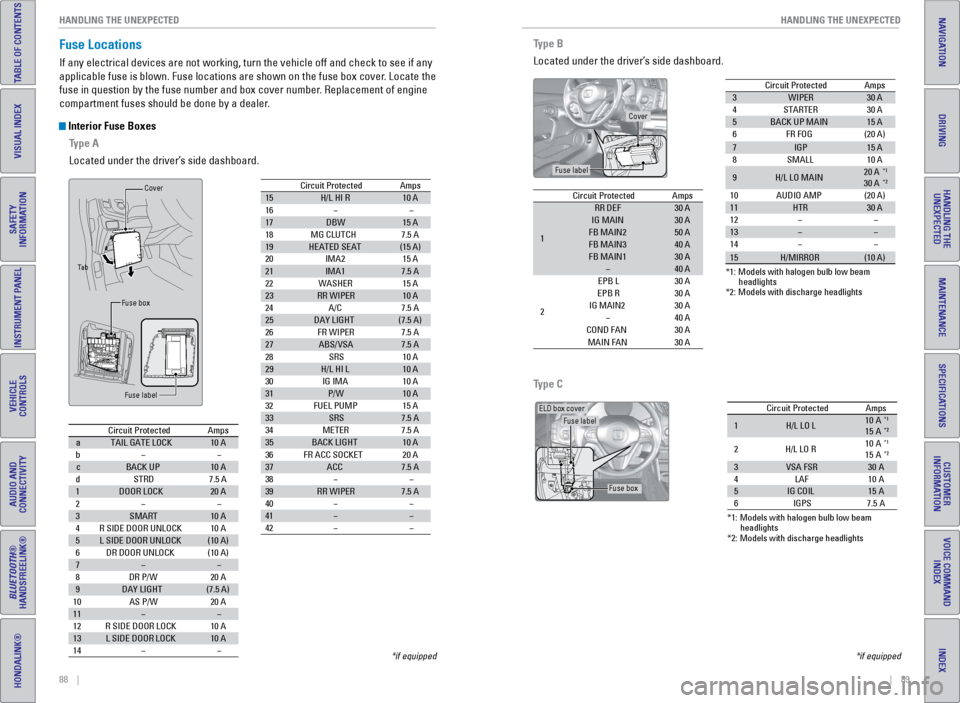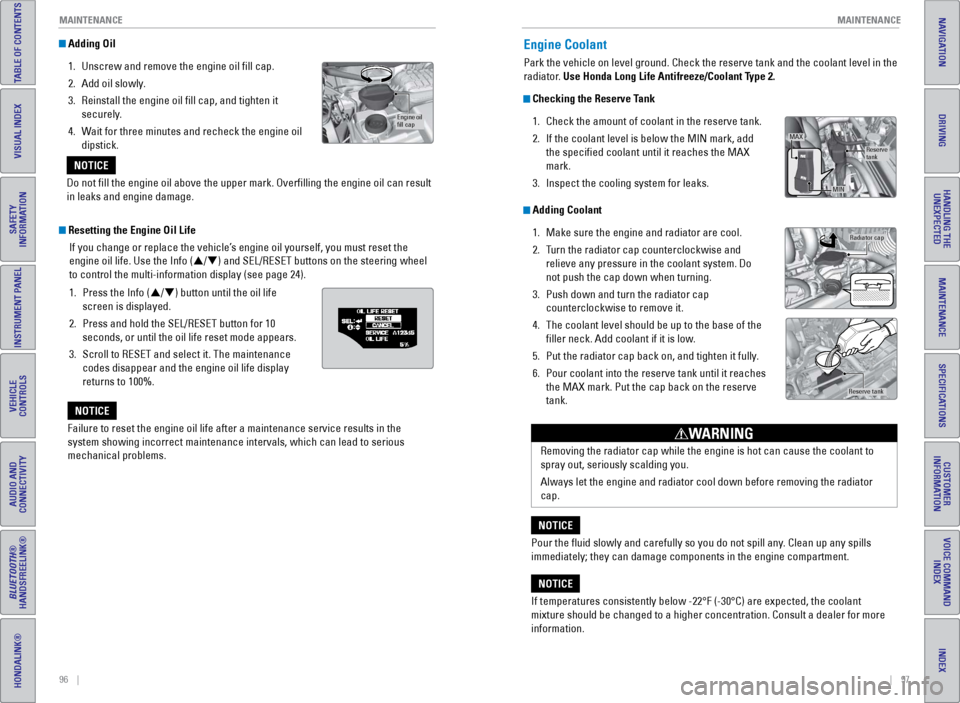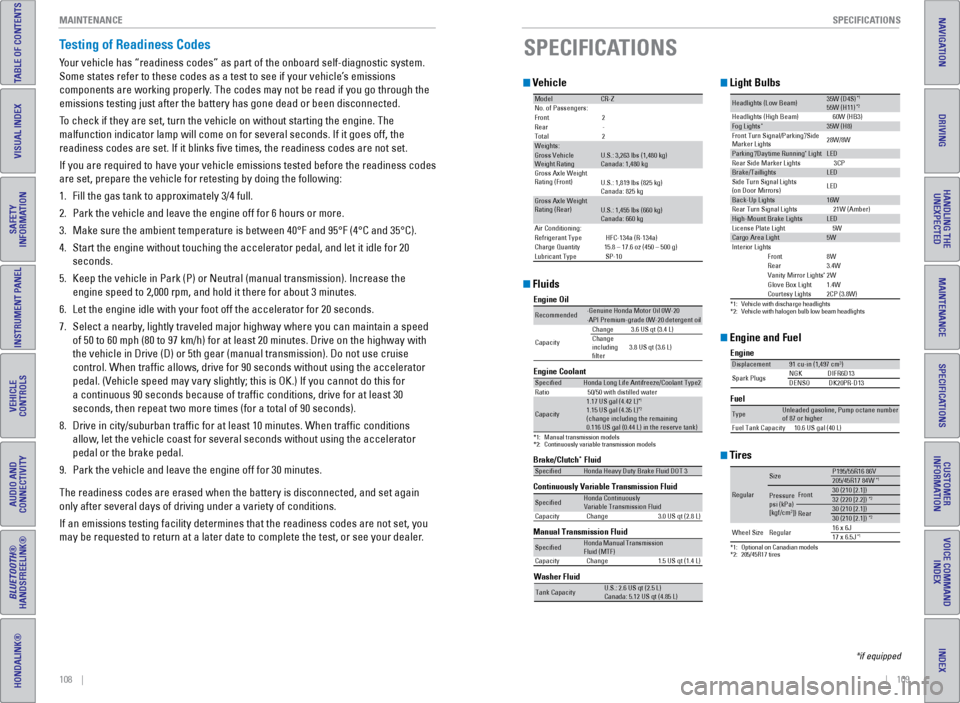oil type HONDA CR-Z 2016 1.G Quick Guide
[x] Cancel search | Manufacturer: HONDA, Model Year: 2016, Model line: CR-Z, Model: HONDA CR-Z 2016 1.GPages: 64, PDF Size: 4.38 MB
Page 6 of 64

4 || 5
S AFETY
S
AFETY
TABLE OF CONTENTS
INDEX
VISUAL INDEX
VOICE COMMAND
INDEX
SAFETY
INFORMATION
CUSTOMER
INFORMATION
INSTRUMENT PANEL
SPECIFICATIONS
VEHICLE
CONTROLS
MAINTENANCE
AUDIO AND
CONNECTIVITY
HANDLING THE UNEXPECTED
BLUETOOTH®
HANDSFREELINK®
DRIVING
HONDALINK®
NAVIGATION
Carbon Monoxide Gas
The engine exhaust from this vehicle contains carbon monoxide, a colorle\
ss,
odorless, and highly toxic gas. As long as you properly maintain your ve\
hicle and
follow the instructions set forth below, you will not accumulate dangerous levels
of carbon monoxide gas in the vehicle interior.
Have the exhaust system inspected for leaks whenever:
•
The exhaust system is making an unusual noise.
•
The exhaust system may have been damaged.
•
The vehicle is raised for an oil change.
When you operate a vehicle with the hatch open, airflow can pull exhau\
st gas
into the interior and create a hazardous condition. If you must drive wi\
th the hatch
open, open all the windows and set the climate control system as shown b\
elow
.
1.
Select the fresh air mode.
2.
Select the mode.
3.
Set the fan speed to high.
4.
Set the temperature control to a comfortable setting.
Adjust the climate control system in the same manner if you sit in your \
p
arked
vehicle with the engine running.
Carbon monoxide gas is toxic. Breathing it can cause unconsciousness and\
even kill you.
Avoid any enclosed areas or activities that expose you to carbon monoxide\
.
WARNING
An enclosed area such as a garage can quickly fill up with carbon mono\
xide gas.
Do not run the engine with the garage door closed. Even when the garage \
door is
open, drive out of the garage immediately after starting the engine.
Seat Belts
A seat belt is your best protection in all types of collisions. Airbags \
are designed to
supplement seat belts, not replace them. So even though your vehicle is \
equipped
with airbags, make sure you and your passengers always wear your seat belts and
wear them properly.
Lap/Shoulder Seat BeltsBoth seating positions are equipped with lap/shoulder seat belts with em\
ergency
locking retractors. In normal driving, the retractor lets you move freel\
y while
keeping some tension on the belt. During a collision or sudden stop, the\
retractor
locks to restrain your body.
The passenger’s seat belt has a lockable retractor that must be properly activated
when using a forward-facing child seat, should you choose to disregard o\
ur
recommendations and install one.
Both seats are equipped with automatic seat belt tensioners to enhance s\
afety.
The tensioners automatically tighten the seat belts during a moderate to\
severe
frontal collision, sometimes even if the collision is not severe enough \
to inflate the
front airbags.
Proper Use of Seat BeltsFollow these guidelines for proper use:
•
All occupants should sit upright, well back in the seat, and remain in t\
ha
t
position for the duration of the trip. Slouching and leaning reduce the \
effectiveness of the belt and can increase the chance of serious injury \
in a
crash.
•
Never place the shoulder part of a lap/shoulder seat belt under your arm\
or
behind your back. This could cause very serious injuries in a crash.
•
T
wo people should never use the same seat belt. If they do, they could be\
very
seriously injured in a crash.
•
Do not put any accessories on the seat belts. Devices intended to improv\
e
comfort or reposition the shoulder part of a seat belt can reduce the pr\
otective
capability and increase the chance of serious injury in a crash.
•
No one should sit in a seat with an inoperative seat belt or one that do\
es not
appear to be working correctly. Using a seat belt that is not working properly
may not protect the occupant in a crash. Have a dealer check the belt as\
soon
as possible.
Not wearing a seat belt properly increases the chance of a serious injur\
y or
death in a crash, even though your vehicle has airbags.
Be sure you and your passenger always wear seat belts and wear them
properly.
WARNING
Page 48 of 64

88 || 89
HANDLING THE UNEXPECTED
HANDLING THE UNEXPECTED
TABLE OF CONTENTS
INDEX
VISUAL INDEX
VOICE COMMAND
INDEX
SAFETY
INFORMATION
CUSTOMER
INFORMATION
INSTRUMENT PANEL
SPECIFICATIONS
VEHICLE
CONTROLS
MAINTENANCE
AUDIO AND
CONNECTIVITY
HANDLING THE UNEXPECTED
BLUETOOTH®
HANDSFREELINK®
DRIVING
HONDALINK®
NAVIGATION
Fuse Locations
If any electrical devices are not working, turn the vehicle off and chec\
k to see if any
applicable fuse is blown. Fuse locations are shown on the fuse box cover\
. Locate the
fuse in question by the fuse number and box cover number. Replacement of engine
compartment fuses should be done by a dealer.
Interior Fuse Boxes
Type A
Located under the driver’s side dashboard.
*if equipped
Circuit Protecte dAmpsaTAIL GATE LOCK10 Ab��cBACK UP10 AdSTRD7.5 A1DOOR LOCK20 A2��3SMART10 A4R SIDE DOOR UNLOCK10 A5L SIDE DOOR UNLOCK(10 A)6DR DOOR UNLOCK(10 A)7��8DR P/W20 A9DAY LIGHT(7.5 A)10AS P/W20 A11��12R SIDE DOOR LOCK10 A13L SIDE DOOR LOC K10 A14��
15 H/L HI R 10 A
16 � �
17 DBW 15 A
18 MG CLUTCH 7.5 A
19 HEATED SEAT (15 A)
20IMA2 15 A
21 IMA1 7.5 A
22 WASHER 15 A
23 RR WIPER 10 A
24 A/C 7.5 A
25 DAY LIGHT (7.5 A)
26 FR WIPER 7.5 A
27 ABS/VSA 7.5 A
28 SRS 10 A
29 H/L HI L1 0 A
30 IG IMA 10 A
31 P/W1 0 A
32 FUEL PUMP 15 A
33 SRS 7.5 A
34 METER 7.5 A
35 BACK LIGHT 10 A
36 FR ACC SOCKET 20 A
37 ACC 7.5 A
38 � �
39 RR WIPER 7.5 A
40 � �
41 ��
42 ��
Circuit Protected
Amps
Fuse labelCove
r
Fuse bo x
Ta b
Circuit Protecte d Amps
a TAIL GATE LOCK 10 A
b � �
c BACK UP 10 A
d STRD 7.5 A
1 DOOR LOCK 20 A
2 � �
3 SMART 10 A
4 R SIDE DOOR UNLOCK 10 A
5 L SIDE DOOR UNLOCK (10 A)
6 DR DOOR UNLOCK (10 A)
7 � �
8 DR P/W 20 A
9 DAY LIGHT (7.5 A)
10 AS P/W 20 A
11 � �
12 R SIDE DOOR LOCK 10 A
13 L SIDE DOOR LOC K10 A
14 � �
15H/L HI R10 A16��17DBW15 A18MG CLUTCH7.5 A19HEATED SEAT(15 A)20IMA215 A
21 IMA1 7.5 A
22WASHER15 A
23 RR WIPER 10 A
24A/C7.5 A
25 DAY LIGHT (7.5 A)
26FR WIPER7.5 A
27 ABS/VSA 7.5 A
28SRS10 A
29 H/L HI L10 A30IG IMA10 A
31 P/W10 A32FUEL PUMP15 A
33 SRS 7.5 A
34METER7.5 A
35 BACK LIGHT 10 A
36FR ACC SOCKET20 A
37 ACC 7.5 A
38��
39 RR WIPER 7.5 A
40��
41��42��
Circuit Protected
Amps
Type B
Located under the driver’s side dashboard.
*if equipped
Circuit ProtectedAmps
1
RR DEF30 AIG MA IN30 AFB MAIN250 AFB MAIN340 AFB MAIN130 A�40 A
2
EPB L30 AEPB R30 AIG MAIN230 A�40 ACOND FA N30 AMAIN FA N30 A
3 WIPER 30 A
4 STARTER 30 A
5 BACK UP MAIN 15 A
6 FR FOG (20 A)
7 IGP 15 A
8 SMALL 10 A
9 H/L LO MAIN 20
A
*1
30 A*2
10 AUDIO AMP (20 A)
11 HTR 30 A
12 � �
13 � �
14 � �
*1: Models with halogen bulb low beam
headlight s
*2 : Models with discharge headlights
15
H/MIRROR (10 A)
Circuit Protecte
dAmps
Cover
Fuse label
Circuit Protecte d Amps
1 RR DEF
30 A
IG MA IN 30 A
FB MAIN2 50 A
FB MAIN3 40 A
FB MAIN1 30 A
� 40 A
2 EPB L
30 A
EPB R 30 A
IG MAIN2 30 A
� 40 A
COND FA N 30 A
MAIN FA N 30 A3WIPER30 A4STARTER30 A5BACK UP MAIN15 A6FR FOG(20 A)
7IGP15 A8SMALL10 A
9H/L LO MAIN20 A*1
30 A*2
10AUDIO AMP(20 A)11HTR30 A12��13��14��
*1 : Models with halogen bulb low beam
headlight s
*2 : Models with discharge headlights
15H/MIRROR(10 A)
Circuit Protecte dAmps
Type C
*1: Models with halogen bulb low beam
headlights
*2: Models with discharge headlights
Circuit Protecte dAmps
1H/L LO L10A*1
15A*2
2H/L LO R10A*1
15A*2
3VSA FS R30A4LAF10A5IG COIL15A6IGPS7.5A
ELD box cove r
Fuse box
Fuse label
Page 52 of 64

96 || 97
MAINTENANCE
MAINTENANCE
TABLE OF CONTENTS
INDEX
VISUAL INDEX
VOICE COMMAND
INDEX
SAFETY
INFORMATION
CUSTOMER
INFORMATION
INSTRUMENT PANEL
SPECIFICATIONS
VEHICLE
CONTROLS
MAINTENANCE
AUDIO AND
CONNECTIVITY
HANDLING THE UNEXPECTED
BLUETOOTH®
HANDSFREELINK®
DRIVING
HONDALINK®
NAVIGATION
Adding Oil
1.
Unscrew and remove the engine oil fill cap.
2.
Add oil slowly
.
3.
Reinstall the engine oil fill cap, and tighten it
securely
.
4.
W
ait for three minutes and recheck the engine oil
dipstick.
Resetting the Engine Oil Life
If you change or replace the vehicle’s engine oil yourself, you must reset the
engine oil life. Use the Info (p/q) and SEL/RESET buttons on the steering wheel
to control the multi-information display (see page 24).
1.
Press the Info (
p/q) button until the oil life
screen is displayed.
2.
Press and hold the SEL/RESET button for 10
seconds, or until the oil life reset mode appears.
3.
Scroll to RESET and select it. The maintenance
codes disappear and the engine oil life display
returns to 100%.
Failure to reset the engine oil life after a maintenance service results\
in
the
system showing incorrect maintenance intervals, which can lead to seriou\
s
mechanical problems.
NOTICE
Engine oil
�ll ca p
Do not fill the engine oil above the upper mark. Overfilling the eng\
ine oil can result
in leaks and engine damage.
NOTICE
Engine Coolant
Park the vehicle on level ground. Check the reserve tank and the coolant\
level in the
radiator. Use Honda Long Life Antifreeze/Coolant Type 2.
Checking the Reserve Tank
1.
Check the amount of coolant in the reserve tank.
2.
If the coolant level is below the MIN mark, add
the specified coolant until it reaches the MAX
mark.
3.
Inspect the cooling system for leaks.
Adding Coolant1.
Make sure the engine and radiator are cool.
2.
T
urn the radiator cap counterclockwise and
relieve any pressure in the coolant system. Do
not push the cap down when turning.
3.
Push down and turn the radiator cap
counterclockwise to remove it.
4.
The coolant level should be up to the base of the
filler neck. Add coolant if it is low
.
5.
Put the radiator cap back on, and tighten it fully
.
6.
Pour coolant into the reserve tank until it reaches
the MAX mark. Put the cap back on the reserve
tank.
Reserve
tank
MAX
MIN
Radiator cap
Reserve tank
If temperatures consistently below -22°F (-30°C) are expected, t\
he coolant
mixture should be changed to a higher concentration. Consult a dealer fo\
r more
information.
NOTICERemoving the radiator cap while the engine is hot can cause the coolant \
to
spray out, seriously scalding you.
Always let the engine and radiator cool down before removing the radiato\
r
cap.
WARNING
Pour the fluid slowly and carefully so you do not spill any. Clean up any spills
immediately; they can damage components in the engine compartment.
NOTICE
Page 58 of 64

108 || 109
SPECIFICATIONS
MAINTENANCE
TABLE OF CONTENTS
INDEX
VISUAL INDEX
VOICE COMMAND
INDEX
SAFETY
INFORMATION
CUSTOMER
INFORMATION
INSTRUMENT PANEL
SPECIFICATIONS
VEHICLE
CONTROLS
MAINTENANCE
AUDIO AND
CONNECTIVITY
HANDLING THE UNEXPECTED
BLUETOOTH®
HANDSFREELINK®
DRIVING
HONDALINK®
NAVIGATION
Testing of Readiness Codes
Your vehicle has “readiness codes” as part of the onboard self-diag\
nostic system.
Some states refer to these codes as a test to see if your vehicle’s emissions
components are working properly. The codes may not be read if you go through the
emissions testing just after the battery has gone dead or been disconnec\
ted.
To check if they are set, turn the vehicle on without starting the engine\
. The
malfunction indicator lamp will come on for several seconds. If it goes \
off, the
readiness codes are set. If it blinks five times, the readiness codes \
are not set.
If you are required to have your vehicle emissions tested before the rea\
diness codes
are set, prepare the vehicle for retesting by doing the following:
1.
Fill the gas tank to approximately 3/4 full.
2.
Park the vehicle and leave the engine off for 6 hours or more.
3.
Make sure the ambient temperature is between 40°F and 95°F (4°\
C and 3
5°C).
4.
Start the engine without touching the accelerator pedal, and let it idle\
for 20
seconds.
5.
Keep the vehicle in Park (P) or Neutral (manual transmission). Incre\
ase
the
engine speed to 2,000 rpm, and hold it there for about 3 minutes.
6.
Let the engine idle with your foot off the accelerator for 20 seconds.
7.
Select a nearby
, lightly traveled major highway where you can maintain a speed
of 50 to 60 mph (80 to 97 km/h) for at least 20 minutes. Drive on the \
highway with
the vehicle in Drive (D) or 5th gear (manual transmission). Do not u\
se cruise
control. When traffic allows, drive for 90 seconds without using the a\
ccelerator
pedal. (Vehicle speed may vary slightly; this is OK.) If you cannot do this for
a continuous 90 seconds because of traffic conditions, drive for at le\
ast 30
seconds, then repeat two more times (for a total of 90 seconds).
8.
Drive in city/suburban traffic for at least 10 minutes. When traffic\
conditions
allow, let the vehicle coast for several seconds without using the accelerator
pedal or the brake pedal.
9.
Park the vehicle and leave the engine off for 30 minutes.
The readiness codes are erased when the battery is disconnected, and set\
again
only after several days of driving under a variety of conditions.
If an emissions testing facility determines that the readiness codes are\
not
set, you
may be requested to return at a later date to complete the test, or see \
your dealer.
Vehicle
ModelCR-ZNo. of Passengers:
Front2
Rear -
Tota l2
Weights:Gross Vehicle
Weight Rating U.S.: 3,263 lbs (1,480 kg)
Canada: 1,480 kg
Gross Axle Weight
Rating (Front)U.S.: 1,819 lbs (825 kg)
Canada: 825 kg
Gross Axle Weight
Rating (Rear)U.S.: 1,455 lbs (660 kg)
Canada: 660 kg
Air Conditioning:
Refrigerant Type HFC-134a (R-134a)
Charge Quantit y15.8 – 17.6 oz (450 – 500 g)
Lubricant Type SP-10
Engine and Fuel
Engine
FuelDisplacement91 cu-in (1,497 cm3)
Spark Plugs NG
KD IFR6D13
DENSO DK20PR-D13
TypeUnleaded gasoline, Pump octane number of 87 or higher
Fuel Tank Capacity 10.6 US gal (40 L)
Tires
*1:Optional on Canadian model s*2: 205/45R17 tires
Regular
SizeP195/55R16 86 V205/45R17 84W*1
Pressure
psi (kPa)
[kgf/cm
2])
Front30 (210 [2.1])32 (220 [2.2])*2
Rear30 (210 [2.1])30 (210 [2.1])*2
Wheel SizeRegula r16 x 6J17 x 6.5J*1
SPECIFICATIONS
*if equipped
Light Bulbs
*1:Vehicle with discharge headlights*2: Vehicle with halogen bulb low beam headlights
Headlights (L ow Beam)35W (D4S )*155W (H11)*2Headlights (High Beam )60W (HB3)Fog Lights*35W (H8)
Front Turn Signal/Parkin g*/Side
Marker Light s 28W/8W
Pa
rkin g*/Daytime Runnin g* LightLED
Rear Side Marker Lights 3CP
Brake/Taillight sLED
Side Turn Signal Lights
(on Door Mirrors) LE
D
Back-Up Lights16W
Rear Turn Signal Lights 21W (Amber)
High-Mount Brak e LightsLED
License Plate Ligh t5 W
Cargo Area Light5WInteri or Light sFront8WRear3.4WVanity Mirror Lights*2WGlove Box Ligh t1.4WCourtesy Lights2CP (3.8W) Fluids
Brake/Clutch* Fluid
Continuously Variable Transmission Fluid
Manual Transmission Fluid
Speci�edHonda Heavy Duty Brake Fluid DOT 3
Speci�edHonda Continuously
Capacity Change 3.0 US qt (2.8L)
Speci�edFluid (MTF)Capacity Change 1.5 US qt (1.4L)
Engine Oil
Engine Coolan
t
*1: Manual transmission model s
*2: Continuously variable transmission models
Recommended·Genuine Honda Motor Oil 0W-2 0·API Premium-grade 0W-20 detergent oi l
Capacity Change
3.6 US qt (3.4 L)
Change
including
�lter 3.8 US qt (3.6 L)
Speci�e
dHonda Long Life Antifreeze/Coolant Type 2
Ratio 50/50 with distilled wate r
Capacity
1.17 US gal (4.42 L)*11.15 US gal (4.35 L)*2(change including the remaining
0.116 US gal (0.44 L) in the reserve tank )
Washer Fluid
Tank Capacit yU.S.: 2.6 US qt (2.5 L)
Canada: 5.12 US qt (4.85 L)
Variable Transmission Fluid
Honda Manual Transmission